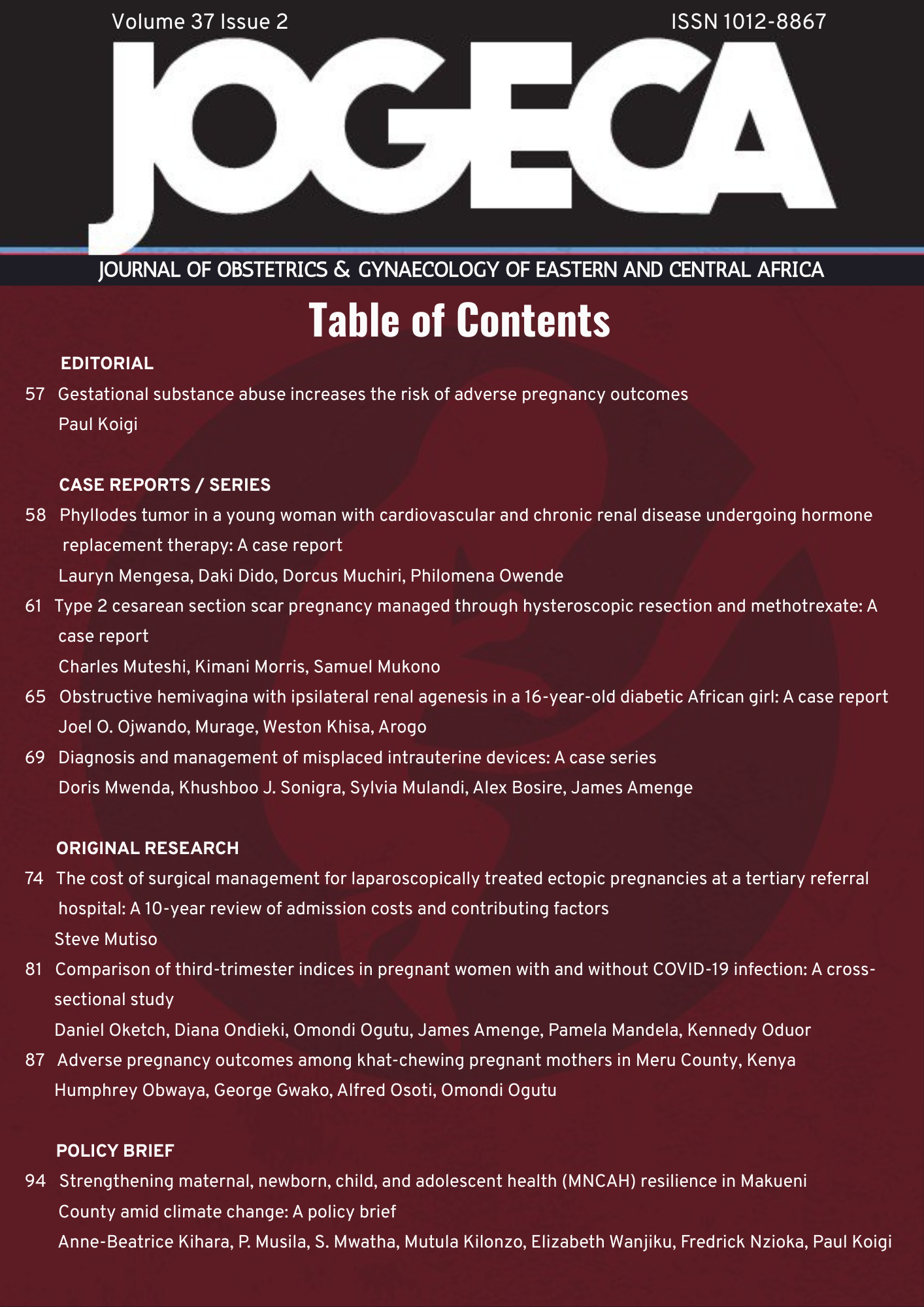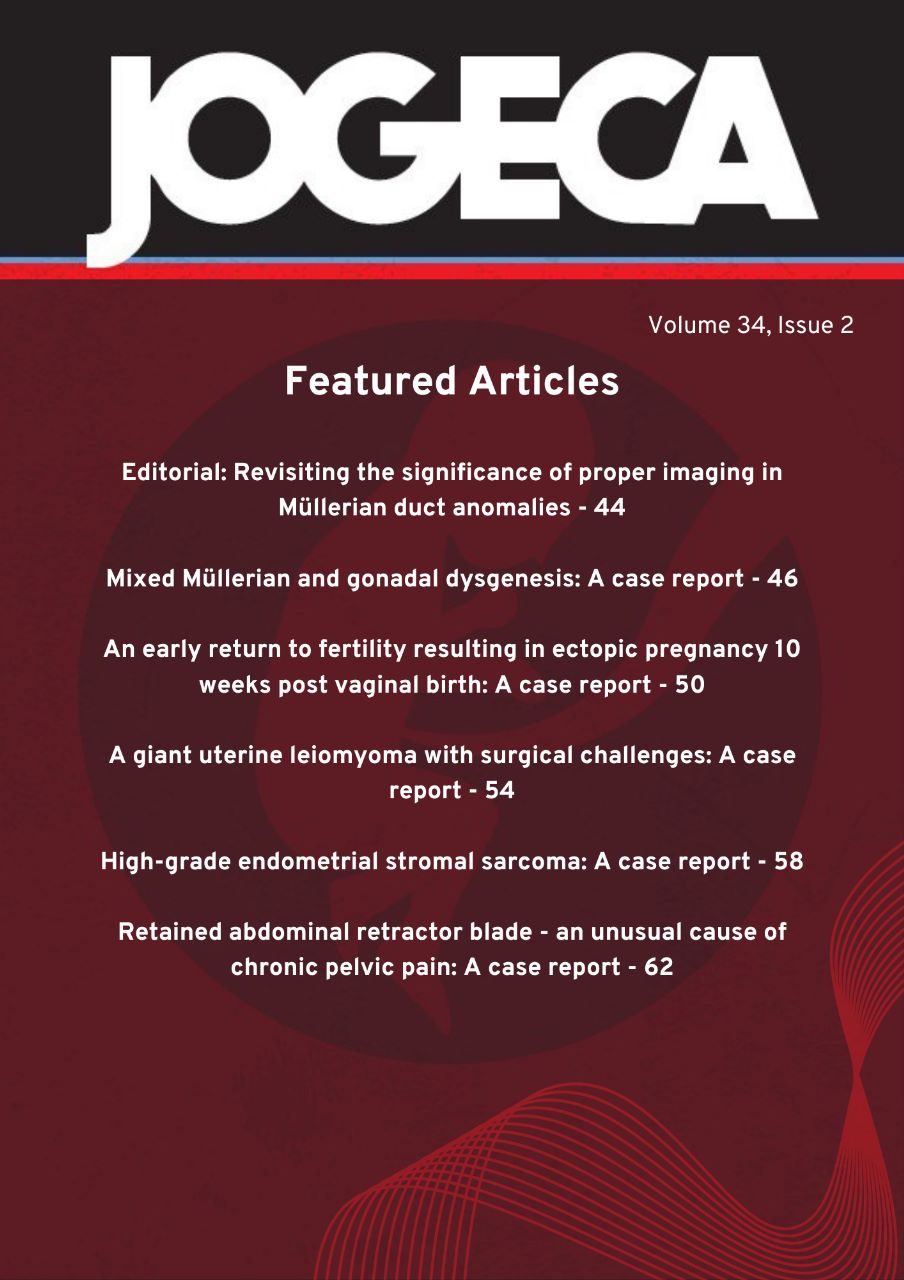Adverse Pregnancy Outcomes Among Khat Chewing Pregnant Mothers in Meru County, Kenya.
DOI:
https://doi.org/10.59692/jogeca.v37i2.389Keywords:
khat, adverse, pregnancy, outcomes, meruAbstract
Background: Khat (Catha edulis) is a green leafy plant containing psychoactive alkaloids, such as cathine and cathinone. Khat use in pregnancy affects maternal and fetal well-being.
Objective: This study aimed to determine the risk of adverse pregnancy outcomes among pregnant women who chew khat compared with pregnant women who do not chew khat in Meru County in 2023.
Methods: A retrospective cohort study was employed at the Meru Teaching and Referral Hospital and Nyambene Level 4 Hospital that compared immediate postpartum mothers who chewed khat during pregnancy (exposed, n=150) and those who did not chew khat during pregnancy (unexposed, n=300). Data on khat chewing during pregnancy and various maternal, fetal, and early neonatal outcomes were collected using a questionnaire. Data were summarized as means, frequency, and percentages and com
pared using the Students t-test, Pearson’s Chi-square, and Fischer’s exact test. All statistical tests were considered significant if the p<0.05.
Results: There was a statistically significant increased risk of preterm birth (AOR 4.44, 3.31-10.92, p 0.001), low birth weight (AOR 2.95, 1.19-7.57, p 0.02), admission to neonatal intensive care unit or newborn unit (AOR 1.13, 1.03-4.10, p 0.01), and postpartum hemorrhage (AOR 12.85, 2.17 – 244.02, p 0.02). An increased risk of premature rupture of membranes was observed, but this was not statistically significant (OR 1.61, 0.9-2.85, p 0.11).
Conclusion: Women who used khat during pregnancy had an increased risk of adverse pregnancy outcomes, including preterm birth, low birth weight, admission to neonatal intensive unit, and postpartum hemorrhage.
Keywords: adverse pregnancy outcomes, khat, Meru
References
Yarom N, Epstein J, Levi H, Porat D, Kaufman E, Gorsky M. Oral manifestations of habitual khat chewing: A case-control study. Oral Surgery, Oral Med Oral Pathol Oral Radiol Endodontology [Internet]. 2010 Jun 1 [cited 2021 Nov 17];109(6):e60–6. Available from: http://www.oooojournal.net/article/S107921041000106X/fulltext
Omar YS, Jenkins A, Altena MVR, Tuck H, Hynan C, Tohow A, et al. Khat Use: What is the problem and what can be done? Biomed Res Int. 2015;2015.
Mwenda JM, Arimi MM, Kyama MC, Langat DK. Effects of khat (Catha edulis) consumption on reproductive functions: A review. East Afr Med J [Internet]. 2003 Jun [cited 2021 Nov 17];80(6):318–23. Available from: https://pubmed.ncbi.nlm.nih.gov/12953742/
Hassan NAGM, Gunaid AA, Murray-Lyon IM. Khat (Catha edulis): Health aspects of khat chewing. Vol. 13, Eastern Mediterranean Health Journal. 2007. p. 706–18.
Yitayih Y, Vanderplasschen W, Vandewalle S, Rita VD, Gilbert L. The effects of khat use during pregnancy on perinatal and maternal outcomes: a meta-analysis. Arch Womens Ment Health [Internet]. 2023;26(1):11–27. Available from: https://doi.org/10.1007/s00737-023-01293-5
Albarmaqi A, Ye-li Y, Riyadh R, Albattal H, Alawadhi ZA. KHAT ( A NATURAL AMPHETAMINE ) AND ITS HEALTH EFFECT : REVIEW * Rowida Distribution and Prevalence : 2021;10(4):295–312.
Alamneh AA, Endris BS, Gebreyesus SH. Caffeine, alcohol, khat, and tobacco use during pregnancy in Butajira, South Central Ethiopia. PLoS One. 2020 May 1;15(5).
Bifftu BB. Prevalence of khat chewing during pregnancy in Ethiopia: a systematic review and meta-analysis. 2020;
Demelash H, Motbainor A, Nigatu D, Gashaw K, Melese A. Risk factors for low birth weight in Bale zone hospitals, South-East Ethiopia : A case-control study. BMC Pregnancy Childbirth. 2015 Oct 13;15(1).
Eriksson M, Ghani NA, Kristiansson B. Khat-chewing during pregnancy-effect upon the off-spring and some characteristics of the chewers. East Afr Med J [Internet]. 1991 Feb;68(2):106—111. Available from: http://europepmc.org/abstract/MED/2040229
Lemieux AM, Li B, Al’Absi M. Khat use and appetite: An overview and comparison of amphetamine, khat and cathinone. J Ethnopharmacol [Internet]. 2015 Feb 3 [cited 2022 Mar 31];0:78. Available from: /pmc/articles/PMC4281284/
Abdel-Aleem MA. Khat Chewing During Pregnancy: an Insight on an Ancient Problem Impact of Chewing Khat on Maternal and Fetal Outcome among Yemeni Pregnant Women. J Gynecol Neonatal Biol. 2015;1(2):1–4.
Khawaja M, Al-Nsour M, Saad G. Khat (Catha edulis) chewing during pregnancy in Yemen: Findings from a national population survey. Matern Child Health J. 2008 May;12(3):308–12.
NACADA. Rapid Situation Assessment of Drugs and Substance Abuse in Kenya. NACADA Rep [Internet]. 2017;1(1):1–119. Available from: http://nacada.go.ke/?page_id=387#
Jansson T, Kristiansson B, Qirbi A. Effect of khat on maternal food intake, maternal weight gain and fetal growth in the late-pregnant guinea pig. J Ethnopharmacol. 1988;23(1):11–7.
Belete S, Asres K, Bekuretsion Y, Ashebir R, Abebe MS, Seyoum G. Toxic Effect of Khat in Rat Embryos and Fetuses. Pasciu V, editor. Biomed Res Int [Internet]. 2021;2021:9933389. Available from: https://doi.org/10.1155/2021/9933389
Mekonnen AG, Hordofa AG, Kitila TT, Sav A. Modifiable risk factors of congenital malformations in bale zone hospitals, Southeast Ethiopia: An unmatched case-control study. BMC Pregnancy Childbirth. 2020 Feb 27;20(1).
Downloads
Published
How to Cite
Issue
Section
Categories
License
Copyright (c) 2025 Humphrey Obwaya, George Gwako, Alfred Osoti, Omondi Ogutu

This work is licensed under a Creative Commons Attribution 4.0 International License.





